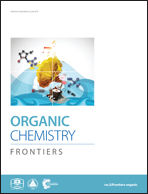Theoretical insights into photo-induced Curtius rearrangement of chlorodifluoroacetyl azide†
Abstract
Upon application of heat or UV light, acyl azides undergo the Curtius rearrangement leading to an isocyanate with the loss of nitrogen gas, which is of great importance in organic chemistry and biological science. The mechanism of the thermal Curtius rearrangement has been made clear, but the photo-induced one remains controversial. In this work, the mechanism of photo-induced Curtius rearrangement of chlorodifluoroacetyl azide F2ClCC(O)N3 has been investigated using the MS-CASPT2//CASSCF method combined with density functional theory (DFT). Our calculations disclosed that illumination with light of 225 nm or 193 nm populates the S2(π1π2*) state or S4(nOπ1*) state of F2ClCC(O)N3 at the Franck–Condon region, followed by internal conversion to the S1 state minimum of (π1π1*) character. The reaction is initiated through the elimination of N2 that leads to a nitrene intermediate in the S1 state. Subsequently, the S1 state nitrene decays to the ground state via an S1/S0 conical intersection, resulting in either nitrene or isocyanate. The obtained results show that F2ClCC(O)N3 prefers to undergo photo-induced Curtius rearrangement in a stepwise mechanism via the nitrene intermediate. This work not only provides a clear mechanism for the Curtius rearrangement of chlorodifluoroacetyl azide, but also gives new insights into the photochemistry of acyl azides and nitrene where conical intersections between excited states and ground states play key roles.


 Please wait while we load your content...
Please wait while we load your content...